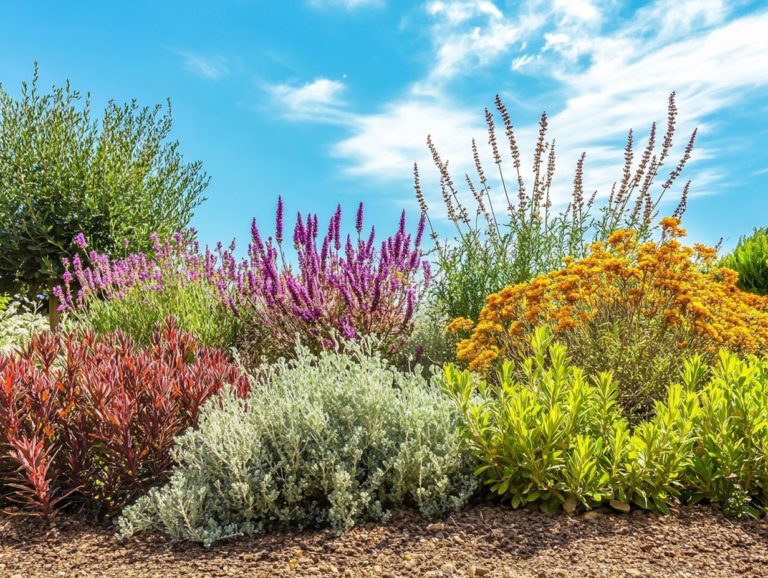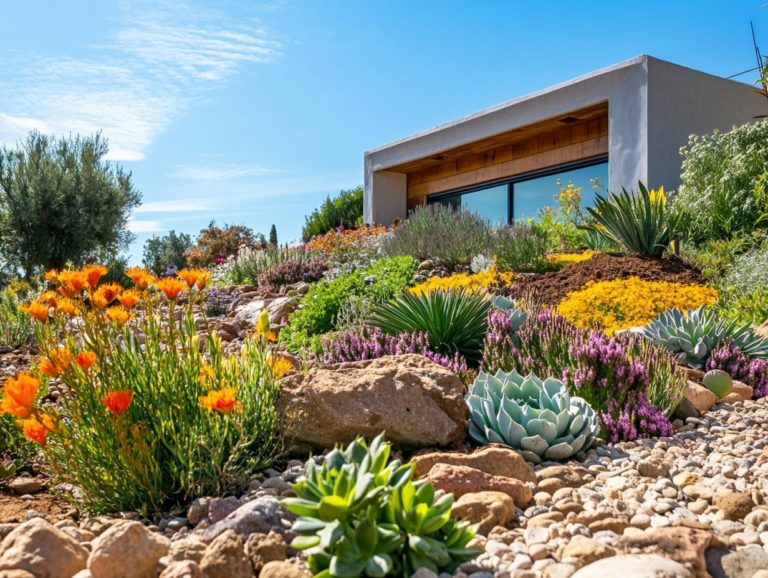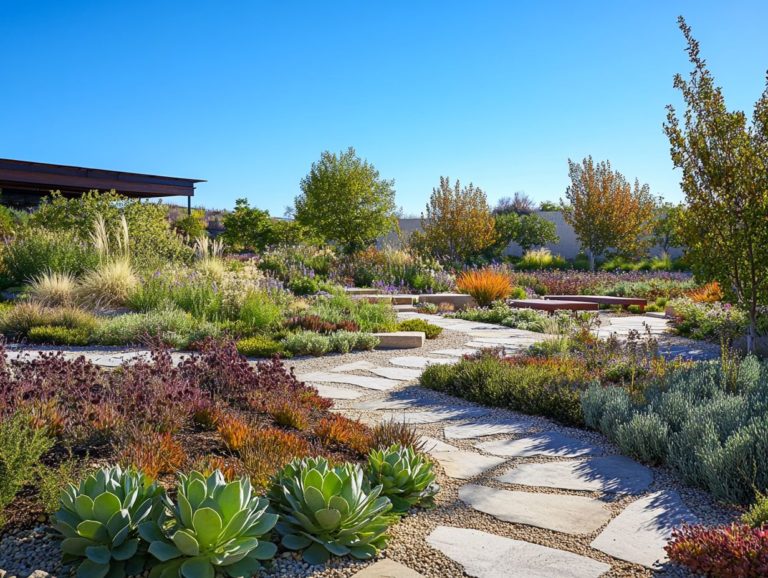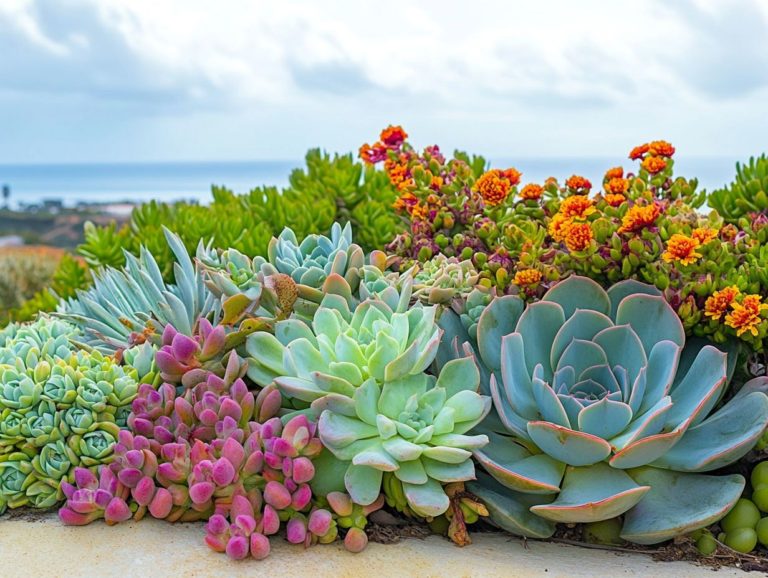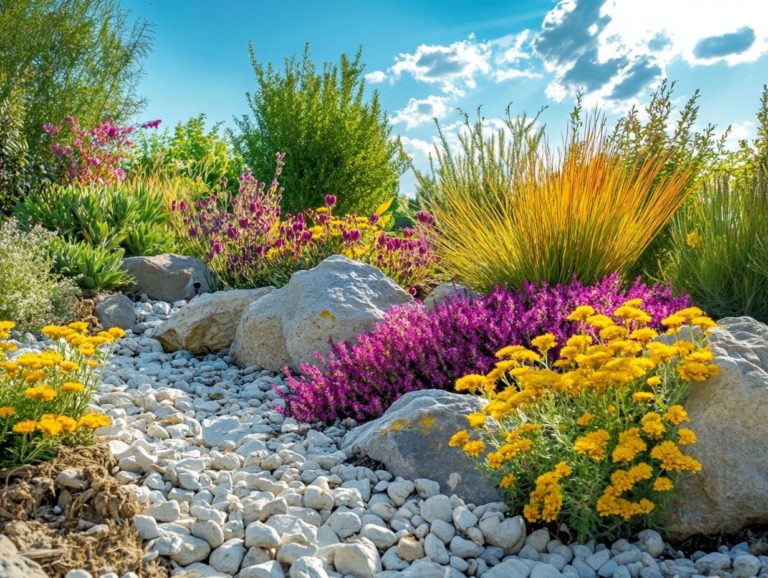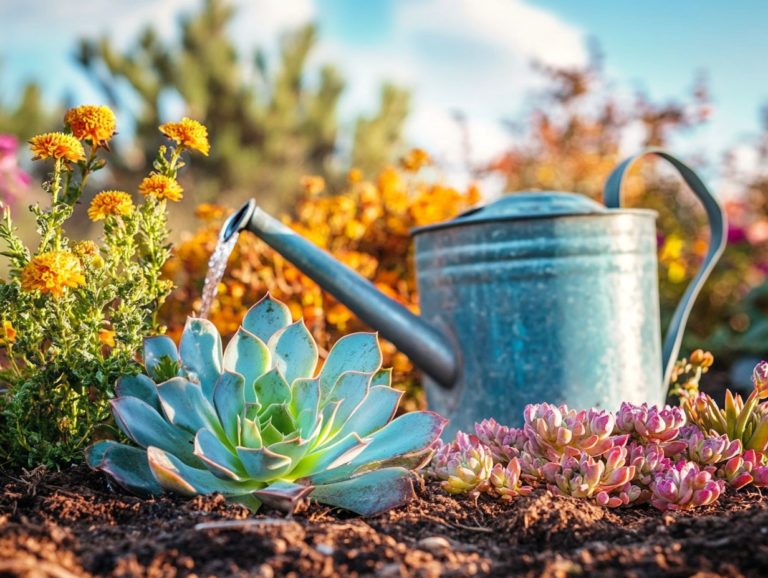The Advantages of Drought-Resistant Plants for Your Home
In a time when water conservation is paramount, choosing drought-tolerant plants can be a savvy move for the eco-friendly gardener looking to transform their garden.
These hardy plants save water and cut down on upkeep, making gardening easier and more enjoyable! From vibrant succulents to stunning xeriscaping a gardening method that reduces or eliminates the need for irrigation there’s a delightful variety to discover.
This article delves into the benefits of incorporating drought-resistant plants into your garden design, offers plant advice for selecting and caring for them, and presents innovative ways to integrate them into your home gardening.
Contents
- Key Takeaways:
- What are Drought-Resistant Plants?
- Benefits of Using Drought-Resistant Plants
- Cost Savings
- Low Maintenance
- Types of Drought-Resistant Plants
- Tips for Choosing and Caring for Drought-Resistant Plants
- Incorporating Drought-Resistant Plants into Your Home
- Frequently Asked Questions
- What are drought-resistant plants and why are they beneficial for my home?
- Do drought-resistant plants require a lot of maintenance?
- Can drought-resistant plants still add beauty to my home’s landscape?
- Will drought-resistant plants attract pests or harmful insects?
- How do drought-resistant plants benefit the environment?
- Are drought-resistant plants more expensive than other plants?
Key Takeaways:
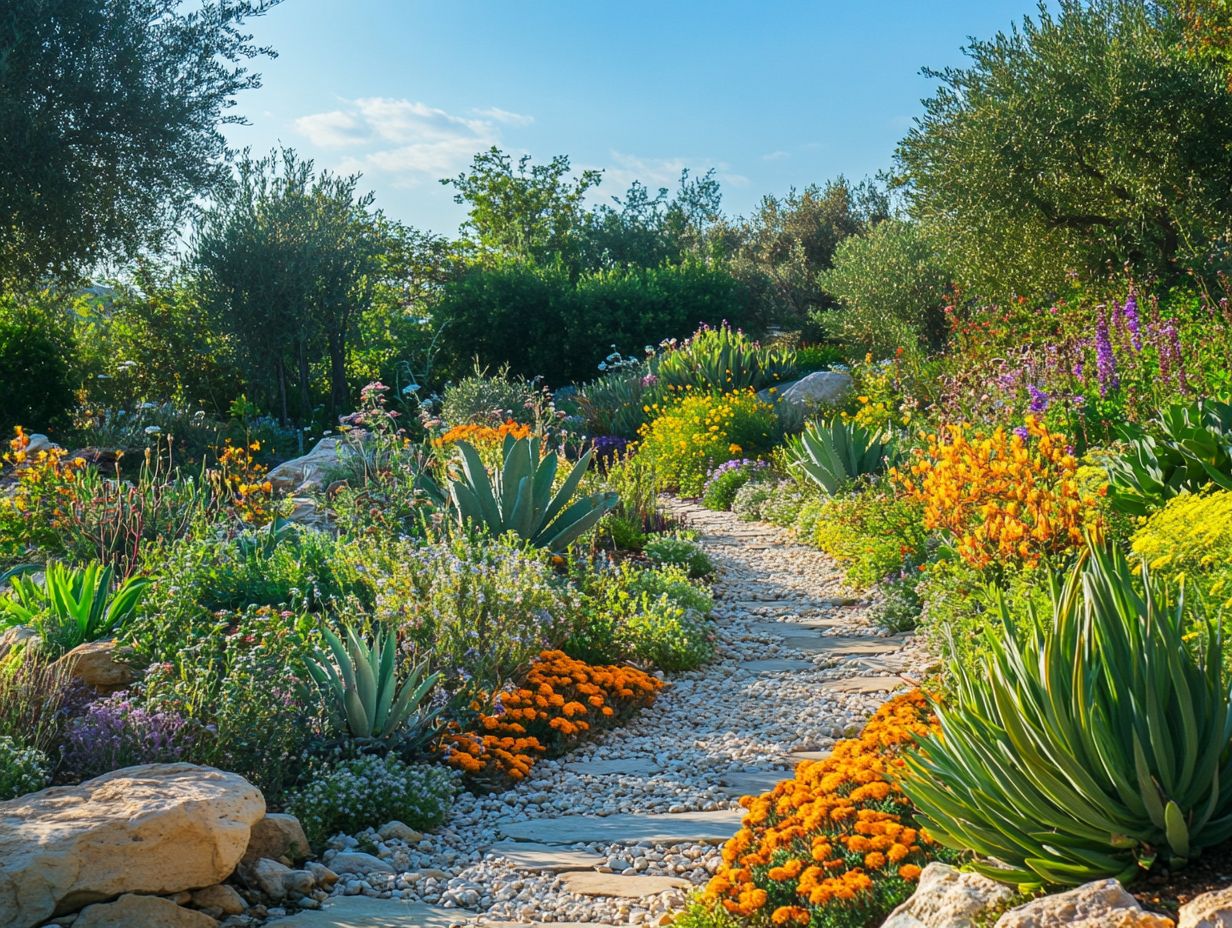
- Drought-resistant plants can help conserve water, save money on utility bills, and require low maintenance, making them a practical and climate-friendly choice for any home.
- There are various types of drought-resistant plants, including succulents and xeriscaping plants, offering a range of options for incorporating them into your home’s design.
- When choosing and caring for resilient plants, consider factors like climate and soil conditions. Provide proper watering and maintenance to ensure their health and longevity.
What are Drought-Resistant Plants?
Drought-resistant plants are remarkable flora that grow well in dry areas with minimal water. They represent an ideal choice for sustainable gardening practices.
Particularly in areas grappling with high temperatures and scant rainfall, these plants enhance the beauty of your landscape while supporting water conservation efforts.
By opting for native and resilient species, you can elevate your landscape design while promoting biodiversity and nurturing a thriving ecosystem.
Benefits of Using Drought-Resistant Plants
The advantages of incorporating unique drought-resistant plants for your home into your gardening endeavors are numerous, especially regarding water conservation, cost savings, and low maintenance. These plants are the smart choice for any homeowner looking to beautify their space while saving money!
Climate change is causing prolonged droughts and soaring temperatures, making drought-resistant plants an essential asset in home gardening. They allow you to cultivate stunning landscapes while also enjoying the health benefits of gardening with drought plants, alleviating the stress of excessive watering or soaring water bills.
Water Conservation
Water conservation is essential, especially if you’re in a drought-prone area. Embracing drought-resistant plants can dramatically cut down your water usage while allowing you to enjoy a vibrant and flourishing garden.
These tough plants thrive on little water, which makes them perfect for your garden! By selecting native and drought-tolerant species, you can enjoy the benefits of using drought-resistant varieties while nurturing a diverse ecosystem in your backyard.
Incorporating organic matter, like compost, into your soil improves its structure, enabling it to hold onto moisture more effectively. Don’t overlook the power of mulching around your plants; this simple strategy significantly reduces evaporation and helps regulate soil temperature.
Together, these techniques not only save water but also cultivate a healthier, more resilient garden that can thrive even in the face of challenging climates.
Start planning your drought-resistant garden today and enjoy a beautiful, low-maintenance landscape!
Cost Savings
One of the most compelling reasons to choose drought-resistant plants is the cost savings they provide, especially when it comes to lowering your water bills for home gardening and enhancing your landscape aesthetics. Understanding the role of drought-resistant plants in landscaping can further highlight their benefits.
By incorporating these low-water options into your landscape design, you can significantly cut down on monthly expenses while still enjoying a stunning array of beautiful and resilient plant varieties.
In many regions, rising water rates make it essential for homeowners to manage this growing expense while maximizing gardening opportunities. Choosing drought-resistant plants that thrive with little water is a smart choice!
These plants also reduce the frequency of maintenance, leading to even more savings on gardening services. For example, those who have made the switch to native succulents and cacti often report slashing their water bills by as much as 50%.
The need for fertilizers and other growth-enhancing products decreases as these hardy plants adapt beautifully to local soil and conditions. This makes them a financially savvy choice for sustainable landscaping.
Low Maintenance
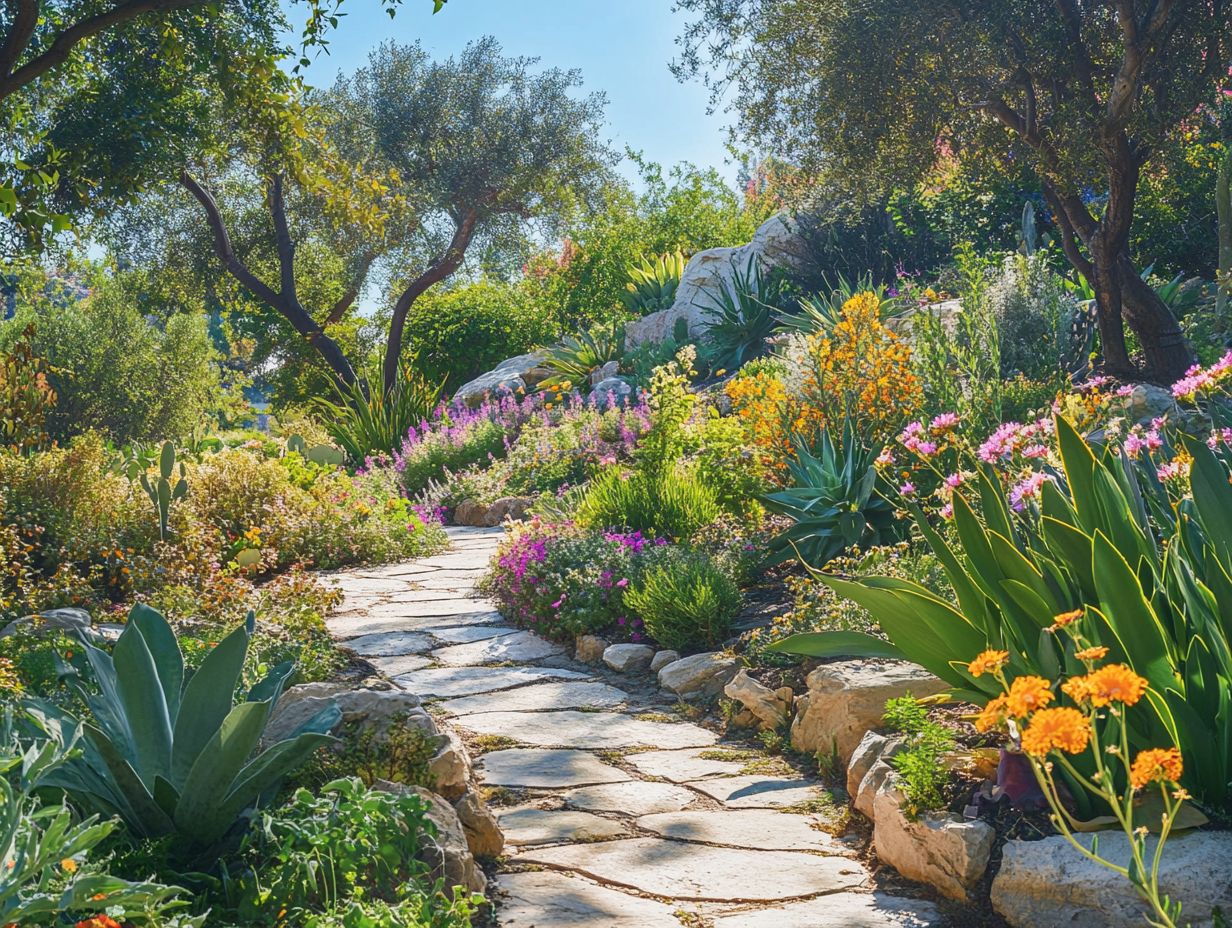
Low maintenance is a compelling advantage of incorporating drought-resistant plants into your gardening efforts. These resilient species generally require less frequent watering and care than traditional plants, making them ideal for busy homeowners or anyone aspiring to create stunning landscapes with minimal effort. Discover more about the benefits of drought-resistant landscaping.
By integrating drought-resistant varieties, you can significantly reduce your watering schedule, ensuring your plants thrive even during the hottest months. These plants have unique adaptations that enable them to store water and flourish in well-draining soils, which are soils that allow excess water to escape easily.
Consider varieties like succulents, lavender, and agave. These exemplify the beauty and practicality of low maintenance gardening. Lavender not only brings vibrant colors and delightful fragrance to your garden but also endures longer dry spells with grace, enhancing your landscape design.
Meanwhile, agave s striking rosettes require minimal care, showcasing how nature has equipped these resilient plants to thrive with little intervention.
Types of Drought-Resistant Plants
Drought-resistant plants offer an impressive array of options, including favorites such as succulents and drought-tolerant varieties. These selections not only bring vibrant colors and unique textures that elevate your garden to new heights but also come with benefits of drought-resistant gardening.
Not only do these plants enhance the aesthetic appeal of your landscape, but they also contribute significantly to water conservation and support biodiversity through creative planters and sustainable gardening.
Embracing these resilient species can transform your outdoor space while championing sustainable practices.
Succulents
Succulents are an exceptional choice for drought-resistant plants, renowned for their unique adaptations that enable them to store water and flourish in arid conditions. This makes them ideal for both outdoor and indoor gardening.
With their array of vibrant colors and distinctive textures, succulents provide an enticing aesthetic while demanding minimal maintenance.
Consider the charming Echeveria, with its rosette shape and striking hues, alongside Aloe, celebrated for its medicinal properties and ease of care. These plants thrive particularly well indoors.
They flourish in bright, indirect sunlight and require only minimal watering, making them accessible even for novice gardeners.
Echeveria tends to appreciate slightly drier soil to avoid root rot, while Aloe revels in a well-draining potting mix. Caring for these resilient plants not only enhances your space but also improves air quality, making them a superb choice for both homes and offices.
Xeriscaping Plants
Imagine a garden that thrives with minimal water! Eco-friendly xeriscaping plants make this possible. These plants are tailored for landscape design that makes the most of water and minimizes irrigation needs, essential for anyone interested in drought-resistant gardening.
Choose the right species for a stunning landscape that demands significantly less maintenance and resources. Among the most sought-after xeriscaping plants are succulents like agave and aloe, known for their ability to store moisture in their leaves. Excellent options also include native grasses such as blue grama and ornamental shrubs like desert marigold, both enriching biodiversity and attracting beneficial pollinators.
These resilient plants withstand arid conditions while adding rich textures and vibrant colors to your garden, enhancing its beauty and promoting environmental health and visual harmony.
Tips for Choosing and Caring for Drought-Resistant Plants
Selecting and nurturing drought-resistant plants can significantly elevate your home gardening experience. By understanding the benefits of native drought-resistant plants, you can ensure your landscape flourishes sustainably, even in the face of climate challenges.
By grasping the essential aspects of plant selection and mastering effective care techniques, you can optimize your efforts, resulting in a thriving garden that flourishes beautifully in arid conditions.
Factors to Consider

When choosing drought-resistant plants for your garden, keep several key factors in mind, such as soil health, deep root establishment, and the specific climate conditions in your area. Understanding these elements empowers you to select plants that thrive and enhance your landscape design.
Soil drainage is pivotal for the success of drought-resistant varieties; overly saturated soil can hinder root development. By incorporating native plants adapted to your local climate, you ll boost biodiversity and reduce maintenance demands. These resilient species create an ecosystem that naturally supports wildlife, enriching your garden further.
Assess your environment s unique characteristics like temperature fluctuations and rainfall patterns to choose varieties that truly align with your garden’s conditions, ensuring a flourishing and sustainable outdoor space.
Proper Care and Maintenance
Proper care and maintenance of drought-resistant plants are crucial for ensuring their longevity and visual appeal. Master effective watering techniques and achieve optimal soil drainage. Incorporate organic matter and recognize each plant’s unique needs to cultivate a thriving environment that minimizes water usage.
Instead of frequent light sprinklings, prioritize a watering schedule focusing on deep soaking. Adding mulch to your garden significantly reduces evaporation and regulates soil temperature.
Prepare your soil with a balanced mix of sand, clay, and organic compost to enhance drainage and enrich it with essential nutrients benefiting your plants’ root systems immensely.
For fertilization, slow-release options are often the way to go. They provide a steady supply of nourishment over time while minimizing the risk of over-fertilization. Consider selecting native drought-resistant varieties; they typically require less maintenance and are naturally adapted to your local climate.
Incorporating Drought-Resistant Plants into Your Home
Incorporating drought-resistant plants into your home elevates the functionality and aesthetics of your outdoor spaces, offering a sustainable solution for gardening in challenging climates.
With careful landscape design and a touch of creative inspiration, craft stunning visual interest while simultaneously reducing water consumption and maintenance efforts.
Transform your garden today and contribute to a sustainable future!
Design Ideas and Inspiration
Transform your garden with creative design ideas that use drought-resistant plants. These plants not only beautify your outdoor space but also conserve precious water resources.
Many homeowners, like you, love these tough plants. They can handle dry conditions and come in many colors. Imagine pairing silvery succulents with bright orange marigolds; this combination adds striking pops of color, reflecting the thought you put into your garden.
Experiment with unique planters like repurposed wooden pallets or decorative rock formations. These not only improve drainage but also enhance your garden’s overall look.
Successful landscaping projects show how thoughtful combinations like layering low-growing ground covers with taller ornamental grasses can create depth and interest, showcasing the true potential of a drought-resistant garden.
Frequently Asked Questions
What are drought-resistant plants and why are they beneficial for my home?
Curious about drought-resistant plants? They thrive on little water, making them perfect for dry climates. They help you save on water usage and keep your bills low!
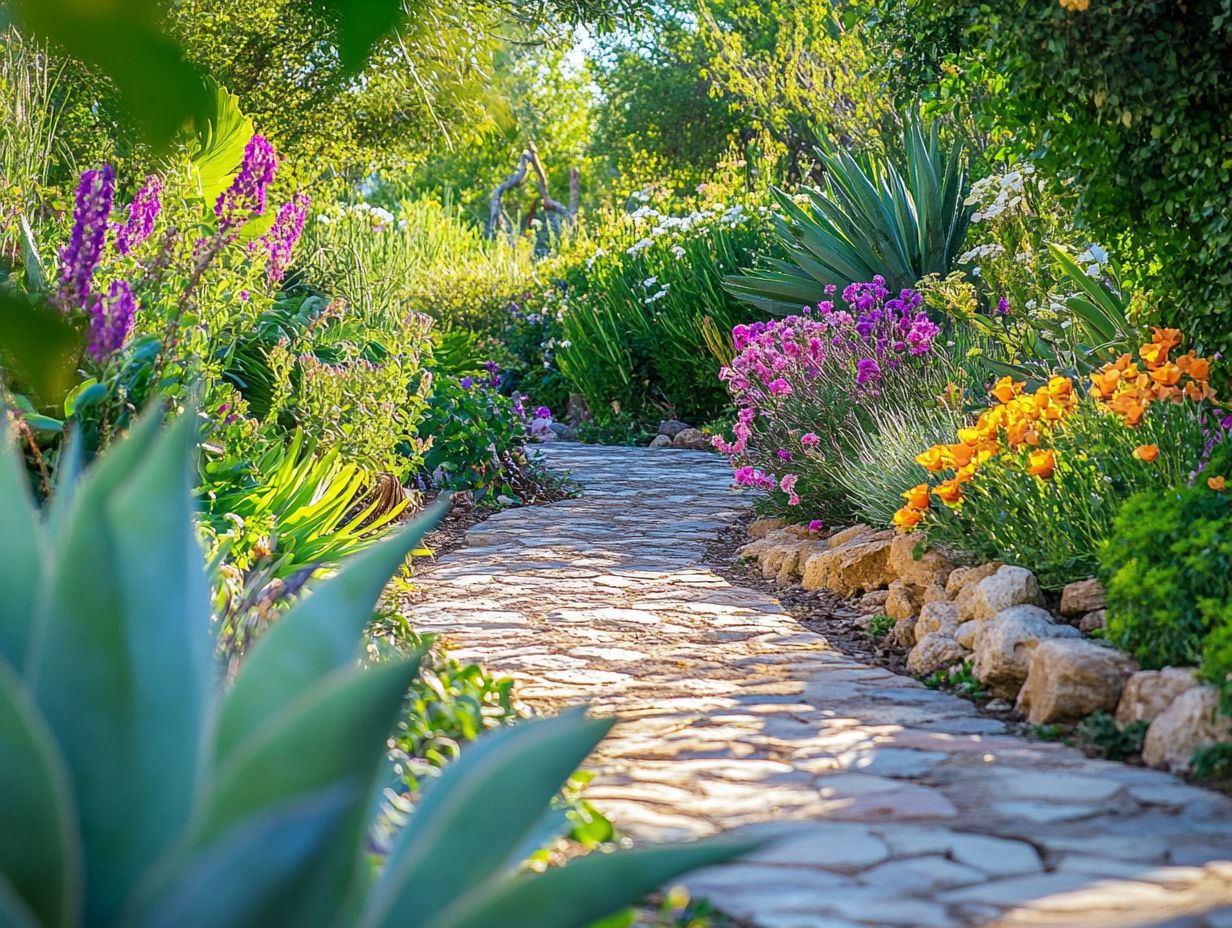
Drought-resistant plants are species that survive with minimal water, making them ideal for areas with limited rainfall or water restrictions. They can reduce your water usage and lower your water bill.
Do drought-resistant plants require a lot of maintenance?
No, drought-resistant plants typically require less maintenance than other plants. Once established, they thrive with minimal watering and pruning, saving you time and effort.
Can drought-resistant plants still add beauty to my home’s landscape?
Absolutely! There are many varieties of drought-resistant plants that come in a range of colors, textures, and sizes, making them a great addition to any landscape design.
Will drought-resistant plants attract pests or harmful insects?
No, drought-resistant plants are not more susceptible to pests than other plants. In fact, some species are known to repel pests and promote biodiversity in your garden.
How do drought-resistant plants benefit the environment?
Drought-resistant plants require less water, which means less strain on local water resources. They also help to prevent erosion and promote soil health.
Are drought-resistant plants more expensive than other plants?
Initially, they may cost more than traditional plants, but in the long run, they can save you money on water and maintenance costs. Plus, they are an investment in a more sustainable and eco-friendly landscape.

